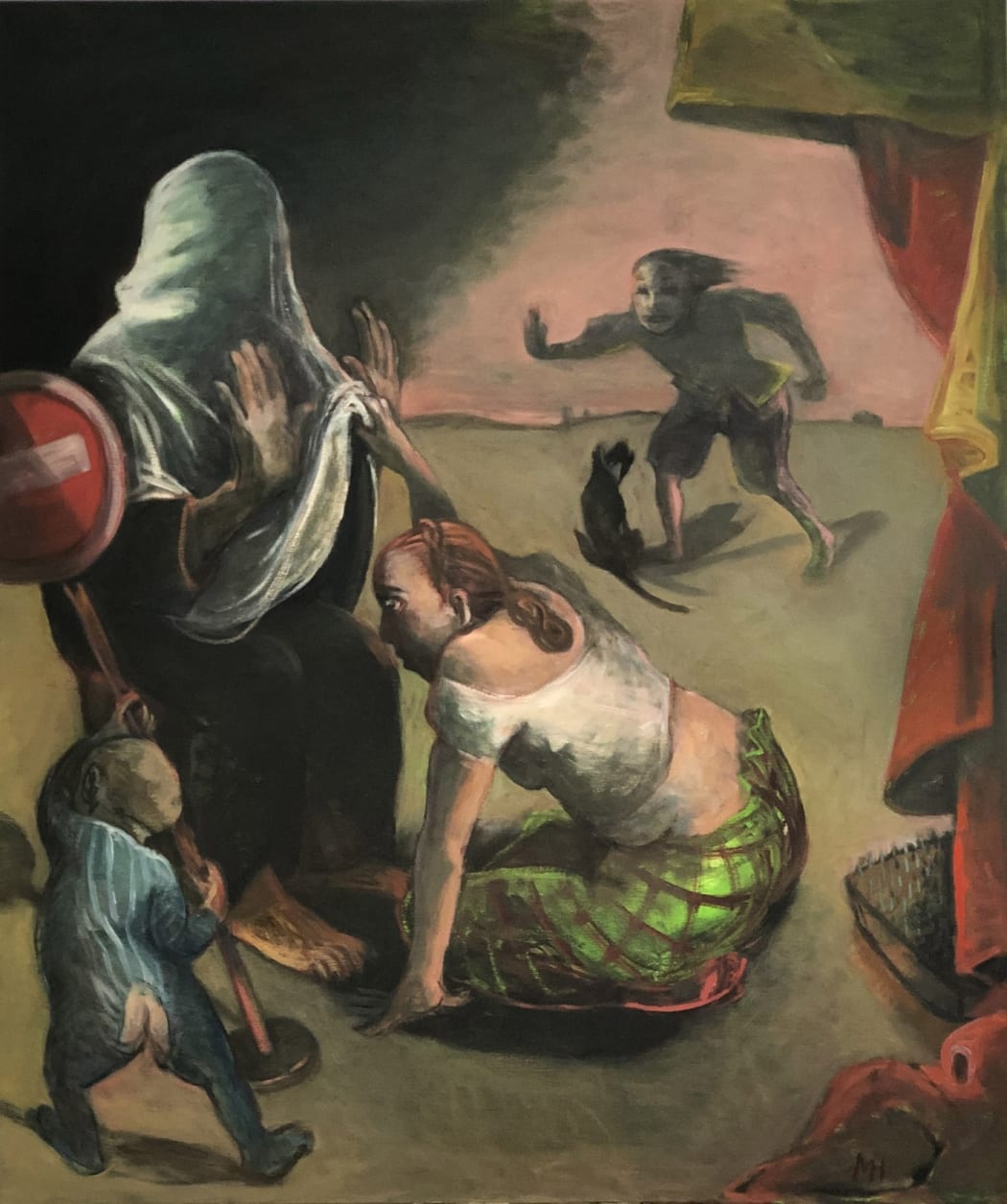
Franz Kafka, one of the most influential writers of the 20th century, continues to resonate far beyond literature, shaping visual art, philosophy, and contemporary culture. His exploration of alienation, absurdity, power, and transformation captures the essence of the Contemporary condition, and the term “Kafkaesque” has come to define unsettling and disorienting experiences that reflect the tension between freedom and control.
Many contemporary artists, including those represented by Aleph Contemporary, grapple with Kafkaesque themes in their work. Through surreal imagery, fragmented narratives, and explorations of psychological unease, artists such as Archie Franks, Alexander Adams, Christy Burdock, Ben Westley Clarke, Chris Burns, and Marcelle Hanselaar reflect Kafka’s enduring impact on the arts. This essay will examine the ways in which these artists engage with Kafka’s legacy, using their practices to explore ambiguity, alienation, and transformation.
Kafka’s Vision: Alienation, Absurdity, and Transformation
Kafka’s works, such as The Trial (1925), The Castle (1926), and The Metamorphosis (1915), are characterised by themes of existential disorientation, oppressive systems, and the fragility of identity. In The Metamorphosis, Gregor Samsa’s transformation into a giant insect serves as a metaphor for alienation and societal rejection, while The Trial chronicles Joseph K.’s struggle against an incomprehensible and arbitrary legal system.
Kafka’s themes align closely with existentialist philosophers such as Jean-Paul Sartre and Albert Camus. Both viewed Kafka as a writer who captured the absurdity of the human condition—the tension between humanity’s search for meaning and a world indifferent to it. These philosophical underpinnings have inspired generations of artists to create works that explore the psychological, social, and existential dimensions of Kafka’s writing.
Archie Franks: Unease in the Ordinary
Archie Franks’ richly detailed paintings transform the everyday into something uncanny and unsettling, a tension that closely mirrors Kafka’s exploration of the grotesque and the familiar. Drawing on the still-life tradition, Franks renders objects and settings with heightened colours and textures, creating a surreal, almost hallucinatory atmosphere.
Much like Kafka’s writing transforms mundane settings—Gregor Samsa’s bedroom or Joseph K.’s office—into oppressive sites of psychological tension, Franks’ work asks viewers to question the boundaries between comfort and unease. His distorted sense of perspective and use of rich, painterly textures hint at the hidden anxieties and absurdities beneath the surface of ordinary life. For collectors, Franks’ work represents a deeply Kafkaesque engagement with the tension between the real and the surreal.
Christy Burdock: Bureaucracy and the Unseen Forces of Society
Christy Burdock’s narrative-driven works offer a satirical yet deeply perceptive view of social structures and the forces that shape human behaviour, aligning with Kafka’s critique of bureaucratic absurdity and power. Her meticulously rendered drawings present worlds populated by anthropomorphic figures engaged in activities that feel at once familiar and surreal.
Burdock’s work draws parallels to Kafka’s The Trial, where the protagonist is caught in a labyrinthine system of authority that defies logic or explanation. Her compositions, often teeming with detail and layered with metaphor, explore how unseen forces—be they cultural, political, or societal—dictate our actions and interactions. Burdock’s ability to create richly symbolic yet ambiguous narratives makes her work a striking visual interpretation of Kafka’s themes of control and alienation.
Ben Westley Clarke: Isolation and Human Struggle
View Ben Westley Clarke’s Work
Ben Westley Clarke’s figurative paintings explore themes of isolation, struggle, and the complexities of human existence, all of which resonate with Kafka’s explorations of the individual’s place within an alienating world. His deeply emotive works often depict people in vulnerable or intimate moments, evoking a sense of empathy that is tinged with unease.
Clarke’s use of shadow, muted tones, and subtle gestures creates a psychological depth that recalls the oppressive atmospheres of Kafka’s stories. Like Kafka’s characters, Clarke’s figures seem trapped within their environments, their inner worlds exposed yet ultimately unknowable. For collectors, Clarke’s work represents a poignant engagement with the fragility and resilience of the human condition, echoing Kafka’s themes of existential uncertainty and alienation.
Alexander Adams: The Poetics of Ambiguity
Alexander Adams’ work offers a poetic exploration of memory, human vulnerability, and the passage of time, resonating deeply with Kafka’s themes of alienation and existential fragility. Known for his monochromatic drawings and stark figurative compositions, Adams distills complex emotional and psychological states into minimalist forms. His work captures the tension between clarity and ambiguity, much like Kafka’s narratives, which reveal profound truths through their sparse and enigmatic prose.
In a recent discussion about his artistic process, Adams highlighted the role of memory and human emotion in his work, describing his practice as a way of investigating the fragility of existence and the fleeting nature of experience. This focus on ephemerality aligns with Kafka’s depictions of characters who grapple with impermanence and the struggle to define their identities within unstable and oppressive systems.
Adams’ preference for black-and-white compositions underscores the starkness and isolation found in Kafka’s worlds. Stripped of colour, his works emphasise the emotional weight of light, shadow, and contrast, evoking the psychological depth of Kafka’s characters, such as Gregor Samsa or Joseph K., whose lives are defined by forces beyond their control.
For collectors, Alexander Adams’ art offers a meditative engagement with the Kafkaesque, using restrained visual language to explore universal themes of loss, resilience, and the fragile beauty of human existence. His work is both timeless and profoundly relevant, capturing the essence of Kafka’s enduring legacy in a contemporary artistic context.
Marcelle Hanselaar: The Subconscious and Transformation
View Marcelle Hanselaar’s Work
Marcelle Hanselaar’s figurative works delve into the subconscious, transformation, and primal aspects of human nature, echoing Kafka’s fascination with the grotesque and the uncanny. Her exhibition at Aleph Contemporary Transfigured Archetypes, curated by Kamini Vellodi showcases surreal, dreamlike imagery where human figures are often merged with animals or depicted in fluid, metamorphic states.
Hanselaar’s exploration of transformation mirrors the central metaphor of The Metamorphosis—the fragile boundary between the human and the inhuman. Her ability to evoke the subconscious aligns with Kafka’s talent for capturing primal fears and desires, making her work deeply resonant for collectors drawn to the psychological and symbolic dimensions of art.
Chris Burns: The Fragmented Body and Systems of Control
Chris Burns’ depictions of fragmented figures and distorted bodies speak to Kafka’s themes of oppression and the dehumanising forces of modernity. His work often focuses on the physical and emotional impact of power structures, much like Kafka’s characters, who are subjected to the absurdity and cruelty of bureaucratic systems.
Burns’ layered approach to figuration—where the body is simultaneously vulnerable and resilient—mirrors Kafka’s ability to capture both the intimate and universal dimensions of human suffering. His art challenges viewers to confront the fragility of the human condition and the unseen forces that shape it, making his work a compelling addition to any collection inspired by Kafka’s legacy.
Why Kafka’s Influence Matters in Contemporary Art
Kafka’s exploration of alienation, transformation, and absurdity remains profoundly relevant in a world that continues to grapple with questions of identity, power, and control. In visual art, his legacy is evident in the embrace of ambiguity, the interrogation of societal systems, and the focus on psychological depth.
Artists like Archie Franks, Christy Burdock, Ben Westley Clarke, Alexander Adams, Marcelle Hanselaar, and Chris Burns channel Kafkaesque themes into their distinct practices. Their works, ranging from surreal figuration to abstracted narratives, offer a rich visual language for engaging with the complexities of the contemporary condition.
Collecting Kafkaesque Art
For collectors, art inspired by Kafka offers an opportunity to acquire pieces that are both conceptually profound and emotionally resonant. These works challenge viewers to engage deeply, question their assumptions, and confront the uncertainties of existence. By collecting pieces from artists like those represented by Aleph Contemporary, you not only invest in thought-provoking contemporary art but also participate in a conversation that bridges literature, philosophy, and the visual arts.
Links:
Paul Klee and the Poetics of Painting
External Links:
Kafka’s modest output had an outsized impact on modern culture








